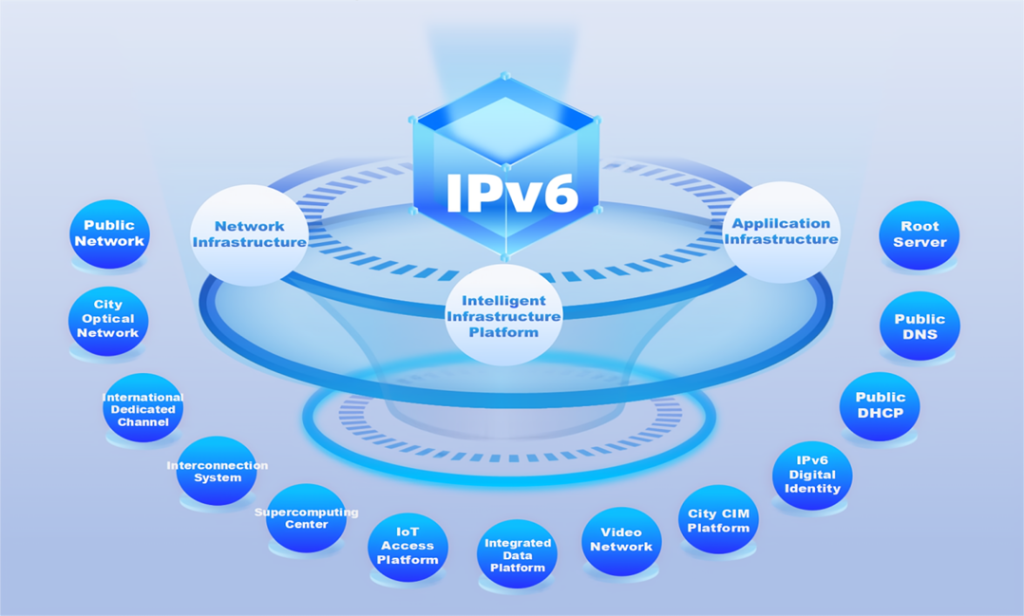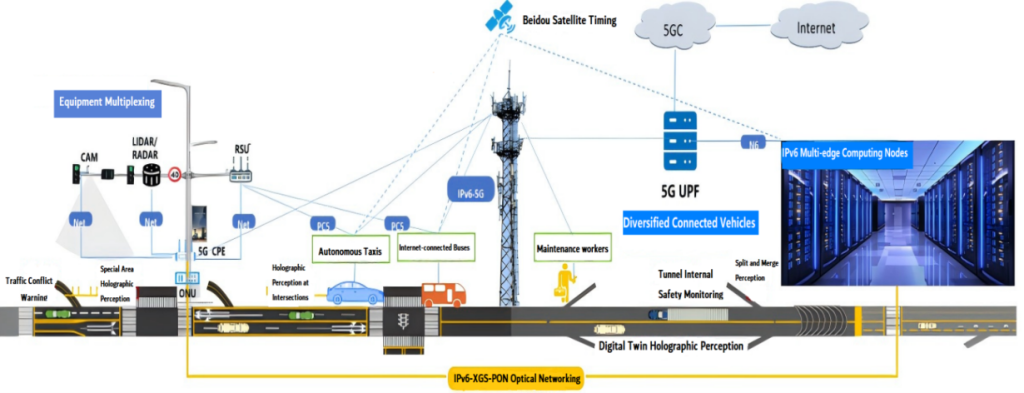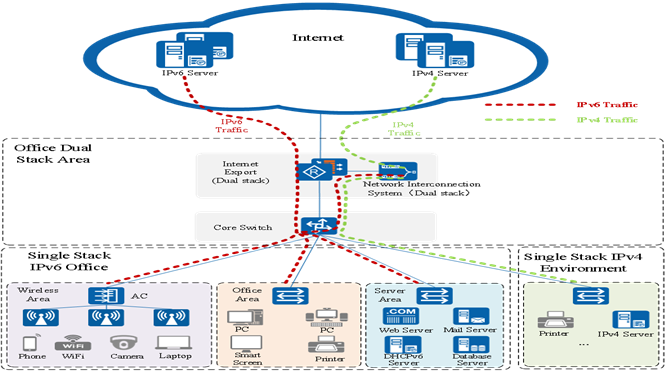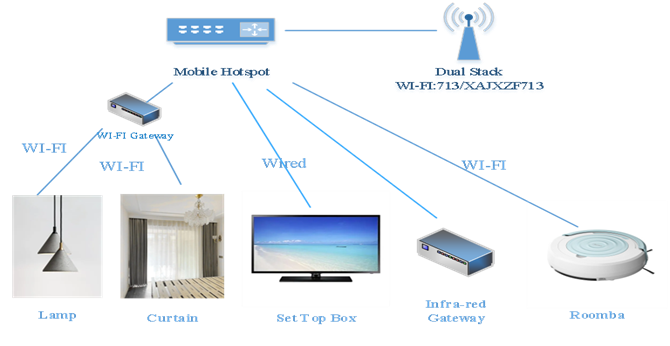2024-10-30 16:59:00
blog.apnic.net

Xiong’an New Area.
As previously discussed in this post, Xiong’an New Area (Xiong’an), a pilot city established in 2017 about 100 kilometres west of Beijing, aims to be a model for future digital cities, built with IPv6-only infrastructure from the start. To achieve this, the local government is prioritizing IPv6 in its top-level planning, designing for the deployment of 198,000 sensors per square kilometre, and supporting over 1 million Internet of Things (IoT) devices per square kilometre. This post will look at the lessons the Xiong’an team has learned so far from building this IPv6-only city.
IPv6-only or IPv4 and IPv6 dual-stack?
As a new city, how should Xiong’an approach IPv6 deployment — IPv6-only or IPv4 and IPv6 dual-stack? While IPv6-only, as shown in Figure 1, simplifies network, application, and terminal device management, compatibility issues make it challenging. On the other hand, dual-stack is easier to implement initially but requires more investment long term. Globally, dual-stack is the standard, offering broader compatibility. However, Xiong’an has chosen an innovative path by deploying IPv6-only across its entire network. This approach not only simplifies future management but also provides valuable insights for other regions considering full IPv6 deployment.

Preparing for IPv6-only deployment
Of course, city-wide greenfield IPv6-only requires careful planning to make deployment a success. Xiong’an prepared for deployment by taking these measures:
- Management: The government delegates IPv6 deployment to the Digital City Construction Office, which coordinates the integration of IPv6 requirements across various departments’ construction projects. A user feedback mechanism is also set up to gather issues encountered during deployment.
- Policies: The government tasks the Intelligent City Innovation Federation with researching and releasing industrial policies through the Industrial Internet Platform. These policies and supporting measures help accelerate city-wide IPv6 deployment.
- Technology: Xiong’an has established the Next Generation Network Laboratory (NGN Lab), using city-level IPv4-IPv6 interconnection systems for application compatibility, network resource management, and deployment monitoring. NGN Lab is currently being upgraded to the Future Network Innovation Institute to further support IPv6 initiatives.
- Publicity: The Xiong’an government promotes IPv6 deployment through various channels, engaging the public and enterprises through events like the ‘Collection of Future City in Xiongan Series Competition’.
Feasibility of full domain IPv6-only deployment
Xiong’an has now deeply integrated full IPv6-only deployment across various sectors, including public services, enterprises, home IoT, and personal applications, demonstrating the feasibility of full domain IPv6-only deployment.
For urban public services, such as roads, schools, hospitals, parks, and communities, all networks now support IPv6-only. Systems that do not yet support IPv6 are managed using translation technologies, while terminals that lack IPv6 compatibility are being replaced in batches. For those terminals where no replacement options are available, Xiong’an is collaborating with manufacturers to develop new IPv6-compatible products.
For enterprises, Xiong’an provides IPv6-only dedicated network lines, ensuring that all business traffic runs on IPv6. To assist with the transition, the government offers subsidies to help reduce adoption costs. Additionally, Xiong’an has leveraged national resources, encouraging major service providers like Tencent and Alibaba to enhance their IPv6 support.
In the home IoT sector, the focus has been on access links, home gateways, applications, and IoT devices. Operators already offer IPv6-only access capabilities, though about 10% of home gateways still lack support. The government and operators are rolling out part-exchange programs to replace these gateways, while translation technologies allow different protocols to work together in home applications. For IoT devices that do not support IPv6, the DS-Lite solution ensures smooth integration into the new network.
For personal applications, the focus has been on mobile networks, devices, apps, and business platforms. The mobile public network in Xiong’an has completed its IPv6-only deployment. Devices and apps that do not support IPv6 are no longer permitted for production or sale. For older business platforms that have not transitioned, translation technologies are being used to facilitate IPv6-only operations.
Examples of IPv6-only deployment in Xiong’an
In Xiong’an, IPv6-only is currently deployed for digital roads, office networks, and leadership housing, which have established a strong foundation for broader IPv6 implementation across the region.
The IPv6 digital road system is vital for urban public services in Xiong’an. It utilizes various sensors and communication devices installed on multifunctional information poles, such as laser radar, electronic checkpoint cameras, vehicle cooperation cameras, and roadside units. All of these are connected through IPv6-only networks to meet the low latency requirements of vehicle-road cooperation services. Currently, the total length of digital roads in Xiong’an has reached 153 kilometres, covering a construction area of 12.7 square kilometres, making it the world’s largest pilot zone for digital roads.

The office network at Xiong’an NGN Lab, a test case from the wider city, includes export routers, core switches, and network interconnection systems (NAT64+ALG), all deployed in a dual-stack environment. Office computers and OA servers operate in an IPv6-only area and communicate with external IPv4 network nodes through network protocol translation equipment and the interconnection system. A limited number of non-IPv6 devices, such as access control systems and older printers, are in the dual-stack area and connect to the public network via DS-Lite. Currently, the lab’s office network is functioning smoothly.

Xiong’an has made significant progress in deploying IPv6-only home IoT applications across various aspects. In the leadership housing, IPv6 home applications have been successfully implemented. Devices such as air conditioners, TVs, lights, curtains, and sweeping robots are all connected through an IPv6-only home network. Once these devices are turned on, they automatically search for and connect to the network via their built-in IPv6 network modules. To date, a total of 2,500 apartments have been equipped with this technology.

What we’ve learned in practice deploying IPv6-only
Over the past four years, Xiong’an has been actively exploring and innovating in the field of IPv6 as part of its ‘Millennium Plan’. As a national comprehensive pilot city for IPv6, Xiong’an has successfully promoted large-scale deployment across various sectors, including urban public services, enterprises, home applications, and personal use, supported by numerous application scenarios and robust mechanisms.
We’ve learned that the successful deployment of IPv6-only requires government intervention, effective coordination, dedicated support teams, industry ecosystem backing, and public awareness initiatives. While the initial costs can be high, IPv6-only deployment proves to be an economically viable and practical solution in the long run.
In conclusion, implementing IPv6-only at scale is entirely achievable with careful planning and stakeholder support.
Watch Guoliang Yang’s full report on Xiong’an during the IPv6 Deployment session at APNIC 58.
Guoliang Yang is the Deputy Director of The New Generation Lab of Xiong’an New Area.
The views expressed by the authors of this blog are their own
and do not necessarily reflect the views of APNIC. Please note a Code of Conduct applies to this blog.
Support Techcratic
If you find value in Techcratic’s insights and articles, consider supporting us with Bitcoin. Your support helps me, as a solo operator, continue delivering high-quality content while managing all the technical aspects, from server maintenance to blog writing, future updates, and improvements. Support Innovation! Thank you.
Bitcoin Address:
bc1qlszw7elx2qahjwvaryh0tkgg8y68enw30gpvge
Please verify this address before sending funds.
Bitcoin QR Code
Simply scan the QR code below to support Techcratic.

Please read the Privacy and Security Disclaimer on how Techcratic handles your support.
Disclaimer: As an Amazon Associate, Techcratic may earn from qualifying purchases.















































![OQTIQ Windshield Phone Mount for Car [Gooseneck 13″ Long Arm] Car Phone Holder Mount…](https://techcratic.com/wp-content/uploads/2024/11/61p78dnmiL._AC_SL1500_-360x180.jpg)










![Trolls Holiday [DVD]](https://techcratic.com/wp-content/uploads/2024/11/718ptSfcL._SL1500_-360x180.jpg)









